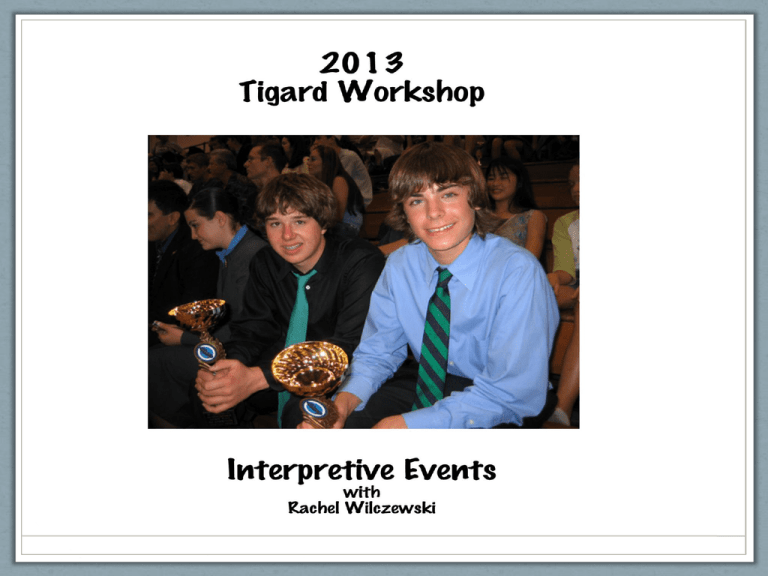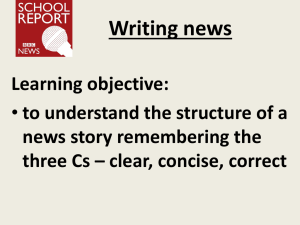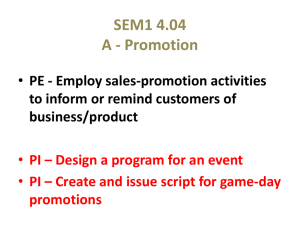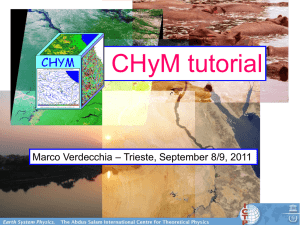The Interpretive Events Humorous, Dramatic, Duo, Poetry, Prose, ELL
advertisement

The Interpretive Events Humorous, Dramatic, Duo, Poetry, Prose, LIBELL Types of Interp Memorized • Length. There is no minimum time limit; contestants shall speak no more than 10 minutes. • Introduction. Each speaker shall appropriately introduce the material. The title and author of the selection must be given. • Presentation. The materials are to be memorized. Physical objects, props or costumes are not allowed. Scripted • Length. There is no minimum time limit; contestants shall speak no more than eight minutes with a 30‐second period of grace including the introduction and reading. • Introduction. Each reader shall appropriately introduce the reading. Introductions should be memorized or delivered extemporaneously. • Presentation. The materials are to be read from a manuscript or printed page. Scripts Rules Taken from the OSAA Speech Handbook Materials. Selections must be cuttings from a single work of literature – from one short story or one play, or one novel, or one or more poems – as described below: (a) Print Publications: includes novels, short stories, plays or poetry, published in print. (b) Digital (Online) Publications: material is only allowed from pre‐approved online publishing sources for the current school year per the official publication of National Forensic League rules. Monologues are allowed. (c) Prohibited Material: not published in print or allowable online material per above, including: (1) Recorded material (videotape, DVDs, audio tape, CDs, MP3s or phonograph recordings). (2) Original material published in a high school publication such as a newspaper, literary magazine, or yearbook. Kissing Frogs aka: Choosing the Right Script Like a good relationship, don’t settle! Read…. a lot… No, I mean it! Know your impersonation abilities And limitations (voices, accents, vocal range) Don’t listen to interpers who tell you NOT to do a particular script Because they’ve seen it done before. It’s your interpretation that makes the piece fresh! Traits of a Good-fit Script Humorous Dramatic • Find something makes you laugh, because if you can visualize the humor, you can imitate it. • Find something that makes you cry…or want to • Multiple characters show off a wider range of interpretive talents. • Single character scripts, or long monologues work well, because they draw your audience into that world and never jolt them out of their suspended disbelief. Cutting Your Script • Once you’ve chosen your script, read and re-read script, so that you are completely familiar with it. • Decide on the theme your cutting will illustrate best for your audience. • Focusing on the essential story you want to tell, choose events throughout the script that will be crucial to telling that story. Mark those on the script. • Also mark any part of the script that may enhance the story with rich details or particularly moving language and imagery. • Choose ending first, then teaser, and then select the passages move the story along the plotline. Make sure your cutting can take your audience on the complete journey from exposition to resolution. Creating Characters • Know thyself! Take some time to run through the vocal and character range checklist with an HONEST friend. • Find voices you can do well, ways you can alter your voice, and your vocal range. • Experiment with stereotypes, break, twist, combine, or reinvent them. • Use all of your tools to create a character: voice, facial expressions, and body posture. • Let your whole body get into it. Become the characters. Technique • • • • • • • Pausing/timing Risks (take them) Innovation Non-verbals Choreography Expressions Snaps Pausing/Timing Don’t be afraid of silence! Use strategic placed pauses • Before a punch line or accentuate the humor. • To create suspense, drama, or to pull your audience in • As an opportunity to have your audience’s attention directed to a key facial expression, gesture, or posture. Risks Break Outside of Your Comfort Zone or Go Big or Go Home Gestures Focal Points • Be deliberate. Commit to a gesture or action. • Choose a focal point for each character. • Lift and lay • If playing multiple characters, use different heights and postures, playing to the width of your audience. • Every movement in your performance should be planned, practiced, and purposeful. • Make sure others can clearly understand your movements. • Be convincing in the emotional expression of your face, specifically your eyes. Innovation Non-Verbals •Use noises and other non-verbals to create sound effects and atmosphere. •Vary your pacing and volume and intensity throughout your interpretation to emotionally move your audience through the piece with you. Choreography Choreography is vitally important to the memorized interp events. Break the mold. This is where true innovation comes into play.Think: How can I use my face, voice and body to bring this scene to life. That being said, here are some basic guidelines: •Should be off script prior to choreography. •Make sure that your audience can see you. Avoid sitting down. •In duo, no touching or looking at one another during actual piece, you may do so in introduction. •Be creative in your use of height, focal points, direction, and indirect interaction with partner. • Use consistent and deliberate gestures and pantomiming. •In duo, play off of partner’s reactions. Expressions An image is worth a thousand words. Make each one count! Snaps and General Delivery Tips •Hula Hoop – perimeter of character zone •Try not to move feet for character changes •Give each character his due. Don’t switch too early or too late. Work on timing of snaps. Either do a crisp snap or seamless meld from one character to another, aka: “morph”. Whichever you choose, be consistent throughout. •Generally, no bow (there are different schools of thought on this). •The same is true for the step forward, step back. Some judges like it, some do not. Do what feels most natural to you. •10-15 seconds of dull eyes or closed eyes before you snap to life and begin your piece. Think of the effectiveness of a closed curtain before the beginning of a play. Poetry • Develop a theme into a complete statement, or even an assertion. No one-word themes. • Run the emotional spectrum with your selections. • Use your voice for the intro and transitions professional tone. • Bring each poem to life with a different voice. Prose While this event is not memorized, it is more challenging than HI, DI and Duo in the sense that you may only use two of your tools: your face and voice. Your gestures and body movement are quite limited. Introductions Two Ways to Begin an Interp • Teaser, then introduction • Gives your audience a taste of your piece, like a movie trailer. • Catches their attention, engages them, because it throws them immediately into the world of your character. • Sets tone of your piece; puts audience in the appropriate mood and to listen. • Begin with actual introduction How to Construct An Introduction for Interp Your Intro Should Not Be… Your Intro Should… • • • • • Give audience a sense of your piece, by establishing characters and setting; enough explanation so audience knows where they are. Be used to establish theme, message, or universal connection to your audience. • Used to describe characters; the description should not have to be stated, but witnessed in your performance. • Longer than 45 seconds/150 words. • Underestimated or underutilized because of time. • Verbose or repetitive • Vague • Impersonal • Read off a script! Can be funny where appropriate Have author and title worked into the last line. Use specific, well-chosen, sophisticated diction Then… Practice! Practice! Practice! Practice! And watch others who have perfected the art of











